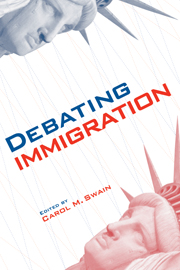Book contents
- Frontmatter
- Contents
- About the Contributors
- Preface
- Acknowledgments
- 1 Introduction
- PART I PHILOSOPHY AND RELIGION
- PART II LAW AND POLICY
- 6 The Undocumented Immigrant
- 7 Good Neighbors and Good Citizens
- 8 Alien Rights, Citizen Rights, and the Politics of Restriction
- PART III ECONOMICS AND DEMOGRAPHICS
- PART IV RACE
- PART V COSMOPOLITANISM
- PART VI CONCLUSION
- Notes
- Index
6 - The Undocumented Immigrant
Contending Policy Approaches
Published online by Cambridge University Press: 05 June 2012
- Frontmatter
- Contents
- About the Contributors
- Preface
- Acknowledgments
- 1 Introduction
- PART I PHILOSOPHY AND RELIGION
- PART II LAW AND POLICY
- 6 The Undocumented Immigrant
- 7 Good Neighbors and Good Citizens
- 8 Alien Rights, Citizen Rights, and the Politics of Restriction
- PART III ECONOMICS AND DEMOGRAPHICS
- PART IV RACE
- PART V COSMOPOLITANISM
- PART VI CONCLUSION
- Notes
- Index
Summary
Although parties to the immigration debate are bitterly divided over policy, virtually everyone agrees that the presence of a large class of unauthorized immigrants in the United States is undesirable. However, enactment of the kind of policies that would be required to fully eliminate the class of undocumented immigrants – whether through exclusion or through legalization – is politically unlikely and probably unachievable in the near term. The current population of undocumented immigrants in the United States is estimated to stand at 10–12 million, an all-time high. Even if Congress manages to pass a guestworker program in the coming period, the population of undocumented immigrants will likely continue to renew itself by way of both unauthorized entry and visa violations.
This being the case, Americans find themselves facing a set of policy questions that go beyond border policy proper. These questions have to do with the proper treatment and status of undocumented individuals once, and while, they are here. In fact, a great deal of the debate over unauthorized immigration in this country is tied up with issues of status and treatment.
Technically speaking, there are two distinct kinds of questions that arise concerning the status and treatment of undocumented immigrants. There are, first of all, questions pertaining to the treatment of these immigrants within the immigration regulatory system itself. At issue are federal policies concerning admission and exclusion of foreigners to and from territory and membership.
- Type
- Chapter
- Information
- Debating Immigration , pp. 85 - 94Publisher: Cambridge University PressPrint publication year: 2007
- 2
- Cited by



